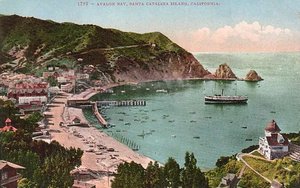Santa Catalina Island, California
|
|
Lightmatter_Avalon_Bay.jpg
Santa Catalina Island, often called simply Catalina Island, is a rocky island off the coast of California.
The 76 mi²/48,000 acre (194 km²) island is located about 22 miles (35 km) south-southwest of San Pedro, Los Angeles, California and is part of Los Angeles County.
It is the only one of the Channel Islands chain to have a permanent civilian settlement and urbanization; most of the 3,000 residents live in the resort city of Avalon, California. The majority of the island is owned by the Catalina Island Conservancy.
| Contents |
History
Prior to the modern era the island was inhabited by people of the Tongva tribe, who also lived in the area of Los Angeles, had villages near present day San Pedro and Playa del Rey, and who regularly traveled back and forth to Catalina for trade.
The sons of Phineas Banning bought the island in 1891 and established the Santa Catalina Island Company to develop it as a resort. Their efforts were set back on November 29, 1915 when a fire burned half of Avalon's buildings, including six hotels and several clubs. World War I also hampered tourism, and the Banning brothers were forced to sell the island.
William Wrigley, Jr. bought Catalina Island in 1919 and devoted himself to preserving and promoting it. In 1921 he sold lots for building in the town of Avalon. The tourism industry was encouraged by the construction of the beautiful Art Deco dance hall in 1929, called the Casino although it has never had any gambling, which has a capacity of over 6,000 dancers. From 1927–1937 pottery and tile were made on the island, and these items are now collectible. The Chicago Cubs, also owned by Wrigley, used the island for the team's spring training.
Catalina's airport was completed in 1946. The 3250 foot runway sits on a mountain top 1602 feet above sea level. Up to this time, the only air service to the island was provided by seaplanes.
In 1975, Philip Wrigley deeded the Wrigley shares in the Santa Catalina Island Company to the Catalina Island Conservancy that he had helped create. It now owns the vast majority of the island.
Wildlife
A herd of American Bison roamed the island for many decades, supposedly first imported in 1924 for the silent film version of Zane Grey's Western tale "The Vanishing American." Boars, brought over as game, also ran free. The island also maintains a small population of Island Foxes, an endangered endemic species.
About 400 species of native plants grow on the island, including the endangered Santa Cruz Island Rock Cress (Sibara filifolia). Several species of plants are found only on Catalina Island, including: Cliff Spurge (Euphorbia misera), Island Cherry (Prunus ilicifolia ssp. lyonii) and Catalina Ironwood (Lyonothamnus floribundus ssp. floribundus). Some of these plants are protected in the island's Wrigley Botanical Gardens.
The Conservancy is tasked with the responsibility of maintaining the island's natural state. It is eradicating invasive weeds and removing all the bison, boars and non-native animals. In December 2004, the Morongo Band of Indians donated $75,000 to relocate the bison to South Dakota, as they have destroyed much of the original, native plant life on the island.
Tourism
About a million tourists visit the island every year; Catalina is serviced by ferries and the "Airport-In-The-Sky."
Only the city of Avalon is open to the public without restrictions. Most of the island is controlled by the Catalina Island Conservancy, a private nonprofit organization. Under an agreement with Los Angeles County, the Conservancy has granted an easement to allow public access, but visitors must first obtain a free permit at the Conservancy's office (on which they declare which parts of the island they intend to visit).
Glass bottom boats tour the reefs and shipwrecks of the area, and scuba diving and snorkeling are popular in the clear water. The area's waters are famous for the schools of flyingfish and the bright orange Garibaldi which teem in local waters. Bus tours are given of the interior.
Two Harbors is the second, and much smaller, resort village on the island. Located at the isthmus of the island, north of Avalon, it is the primary landing spot for those who which to tour the western half of the island. It is accessible by boat from San Pedro and by bus from Avalon. Two Boy Scouts of America councils in Los Angeles County have camps north of Two Harbors; Camp Cherry Valley, operated by The San Gabriel Valley Council, located at Cherry Cove next to Two Harbors, and Camp Emerald Bay, operated by the Los Angeles Area Council, further up the coast. Both are accessible by water taxi from Two Harbors or hiking trails.
Pop culture
In 1958, the Four Preps recorded the hit song "26 Miles (Santa Catalina)."
Actress Natalie Wood drowned off the coast of Catalina in 1981 while on a boating trip with husband Robert Wagner and actor Christopher Walken.
Several scenes from the film Chinatown, starring Jack Nicholson, were filmed on Catalina. The scenes, however, were set in Los Angeles.
The 1988 film Who Framed Roger Rabbit featured an oft referenced vacation to Catalina Island as a subject in the failing relationship between Eddie Valiant and Dolores.
External links
- Catalina Island's Official Website (http://www.catalina.com/)
- The Catalina Island Conservancy (http://www.catalinaconservancy.org/)
- The Santa Catalina Island Company (http://www.scico.com/)
- Two Harbors (http://www.scico.com/twoharbors/)
- Camp Cherry Valley (http://www.sgvcbsa.org/ccv.htm)
- Camp Emerald Bay (http://www.bsa-la.org/camping/eb/emerald_bay.html)
- Satellite Image of Santa Catalina Island (http://www.terraserver.com/imagery/image_gx.asp?cpx=-118.42925863582175&cpy=33.37975552493756&res=256&provider_id=305&t=pan)
| Channel Islands of California: Anacapa Island - San Clemente Island - San Miguel Island San Nicolas Island - Santa Barbara Island Santa Catalina Island - Santa Cruz Island - Santa Rosa Island | 
| |

